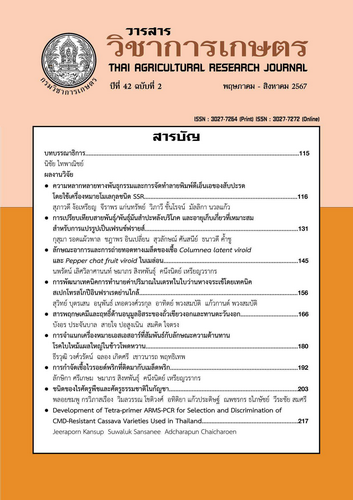ความหลากหลายทางพันธุกรรมและการจัดทำลายพิมพ์ดีเอ็นเอของสับปะรด โดยใช้เครื่องหมายโมเลกุลชนิด SSR
DOI:
https://doi.org/10.14456/thaidoa-agres.2024.10คำสำคัญ:
สับปะรด, ความหลากหลายทางพันธุกรรม, เครื่องหมายโมเลกุลชนิด SSR, ลายพิมพ์ดีเอ็นเอบทคัดย่อ
การวิจัยและพัฒนาพันธุ์สับปะรดเพื่อให้ได้พันธุ์ที่มีผลผลิตและคุณภาพที่ดี ทนทานต่อโรคและแมลง นักปรับปรุงพันธุ์จำเป็นต้องทราบข้อมูลด้านพันธุ์ และข้อมูลความหลากหลายทางพันธุกรรมในระดับดีเอ็นเอ เพื่อการตัดสินใจคัดเลือกพ่อแม่พันธุ์ที่เหมาะสม งานวิจัยนี้มีวัตถุประสงค์เพื่อประเมินความหลากหลายทางพันธุกรรมในระดับดีเอ็นเอและจัดกลุ่มความสัมพันธ์ทางพันธุกรรมของพันธุ์สับปะรดของกรมวิชาการเกษตร จำนวน 57 สายพันธุ์/พันธุ์ ดำเนินการวิจัยระหว่างเดือน ต.ค. 2564 – ก.ย. 2566 โดยการใช้เครื่องหมายโมเลกุลชนิด SSR (simple sequence repeat) ที่ติดฉลากสีฟลูออเรสเซนต์ จำนวน 20 คู่ไพรเมอร์ ผลการทดลองพบว่า ไพรเมอร์ทั้ง 20 คู่ไพรเมอร์ สามารถจำแนกความแตกต่างทางพันธุกรรมของพันธุ์สับปะรดได้ดี พบอัลลีลที่เกิดขึ้นทั้งหมด 105 อัลลีล มีอัลลีลต่อตำแหน่ง 3 – 9 อัลลีล มีค่าเฉลี่ย 5.3 อัลลีล/ตำแหน่ง อัลลีลที่พบทั้งหมดแสดงความแตกต่างกันคิดเป็น 100% แถบดีเอ็นเอ มีขนาดตั้งแต่ 94 – 400 คู่เบส มีค่า PIC (polymorphism information content) อยู่ระหว่าง 0.44 – 0.67 หรือเฉลี่ย 0.59 เมื่อนำข้อมูลที่ได้มาจัดกลุ่มความสัมพันธ์ทางพันธุกรรมด้วยวิธี unweighted pair group method with arithmetic mean และวิเคราะห์ความสัมพันธ์ทางพันธุกรรม ด้วยโปรแกรม NTSYSpc version 2.10e พบว่า ค่าสัมประสิทธิ์ความเหมือนทางพันธุกรรม อยู่ระหว่าง 0.50 – 1.00 สามารถจัดกลุ่มความสัมพันธ์ทางพันธุกรรมของสับปะรดได้เป็น 5 กลุ่ม ซึ่งสอดคล้องกับประวัติพันธุ์และการจัดกลุ่มพันธุ์ตามลักษณะสัณฐานวิทยา โดยมีค่า cophenetic correlation (r) 0.85 แสดงว่า มีการจัดกลุ่มได้ในระดับที่ดีและมีความแตกต่างอย่างชัดเจน จากการศึกษาแสดงให้เห็นว่า เครื่องหมายโมเลกุลชนิด SSR มีความเหมาะสมสำหรับนำไปใช้จำแนกความแตกต่างทางพันธุกรรมระหว่างพันธุ์สับปะรด เพื่อระบุเอกลักษณ์ประจำพันธุ์ สามารถใช้เป็นข้อมูลประกอบการตัดสินใจคัดเลือกพ่อแม่พันธุ์ในงานด้านการปรับปรุงพันธุ์สับปะรดต่อไป
เอกสารอ้างอิง
กิตติพัฒน์ อุโฆษกิจ. 2564. เครื่องหมายโมเลกุลเพื่อการปรับปรุงพันธุ์พืช. สำนักพิมพ์มหาวิทยาลัยธรรมศาสตร์ ปทุมธานี. 393 หน้า.
ทวีศักดิ์ แสงอุดม. 2560. การจัดการการผลิตสับปะรดคุณภาพ. สถาบันวิจัยพืชสวน กรมวิชาการเกษตร, กรุงเทพฯ. 184 หน้า.
มนตรี กล้าขาย. 2560. MD-2: สับปะรดผลสดพันธุ์ใหม่ที่ครองใจคนทั้งโลก. แหล่งข้อมูล : https://www.technologychaoban.com/agricultural-technology/article_33935. สืบค้น: 23 พฤษภาคม 2567.
มนตรี กล้าขาย. 2563. MG-3: สับปะรดพันธุ์ใหม่ รสหวานได้ใจ ผลใหญ่จากฟิลิปปินส์. แหล่งข้อมูล : https://www.technologychaoban.com/agricultural-technology/article_136154. สืบค้น: 19 มีนาคม 2567.
สาวบางแค 22. 2565. ชื่อสับปะรดปัตตาเวียเหมือนกัน แต่รสชาติความอร่อยต่างกัน. แหล่งข้อมูล : https://www.technologychaoban.com/agricultural-technology/article_205445. สืบค้น: 23 พฤษภาคม 2567.
สำนักงานเศรษฐกิจการเกษตร. 2565. ภาพรวมสถานการณ์สินค้าเกษตรปี 2565 และแนวโน้มปี 2565. แหล่งข้อมูล: http://www.oae.go.th. สืบค้น: 2 ธันวาคม 2566.
Abdalah, M., M.S. Seth, A. Ndee, E.E. Mneney, G. Mbwambo, K. Lema, A. Godfrey, L. Mrema, A. Kachiwile, E. Mrema and T.J. Msogoya. 2018. Diversity and genetic identity of pineapple [Ananas comosus (L.) Merr.] in Tanzania based on microsatellite markers. African Journal of Biotechnology. 17(26): 811 – 817.
Botstein, D., R.L. White, M. Skolnick and R.W. Davis. 1980. Construction of a genetic linkage map in man using restriction fragment length polymorphisms. American Journal of Human Genetics. 32(3): 314 – 331.
Costa, T.R.D., P.S.V. Filho, M.C. Gonçalves-Vidigal, M.Z. Galván, G.F. Lacanallo, L.I. da Silva and M.V. Kvitschal. 2013. Genetic diversity and population structure of sweet cassava using simple sequence repeat (SSR) molecular markers. African Journal of Biotechnology. 12(10): 1040 – 1048.
Dellaporta, S.L., J. Wood and J.B. Hicks. 1983. A plant DNA minipreparation: Version II, Plant Molecular Biology Reporter. 1(4): 19 – 21.
Hokanson, S.C., A.K. Szewc-McFadden, W.F. Lamboy and J.R. McFerson. 1998. Microsatellite (SRR) markers reveal genetic identities, genetic diversity and relationships in a Malus x domestica borkh. core subset collection. Theoretical and Applied Genetics. 97(5): 671 – 683.
Nei, M. 1978. Estimation of average heterozygosity and genetic distance from a small number of individuals. Genetics. 89(3): 583 – 590.
Py, C., J.J. Lacoeuilhe and C. Teisson. 1987. The Pineapple Cultivation and Uses. G.P. Maisonneuve et Larose Publisher, Paris. 568 p.
Rohlf, F.J. 2000. NTSYS-pc: Numerical Taxonomy and Multivariate Analysis System Version 2.1. Exeter Publishing Setauket, New York.
Sirithunya, P., E. Roumen, S. Mongkolsomrit, S. Sriprakhon, P. Hutamekalin and T. Sreewongchai. 2001. Instruction Manual Workshop on Molecular Genetic Analysis on Diversity of Blast Pathogen in Thailand. Yothee laboratory Unit Bangkok, Thailand.
Yanfeng, D., J. Liu, J. Xu, C. Bian, S. Duan, W. Pang, J. Hu, G. Li and L. Jin. 2019. DNA fingerprinting and genetic diversity analysis with simple sequence repeat markers of 217 potato cultivars (Solanum tuberosum L.) in China. American Journal of Potato Research. 96: 21 – 32.
Yu, J.Z., D.D. Fang, R.J. Kohel, M. Ulloa, L.L. Hinze, R.G. Percy, J. Zhang, P.W. Chee, B.E. Scheffler and D.C. Jones. 2012. Development of a core set of SSR markers for the characterization of Gossypium germplasm. Euphytica. 187(2): 203 – 213.
ดาวน์โหลด
เผยแพร่แล้ว
รูปแบบการอ้างอิง
ฉบับ
ประเภทบทความ
สัญญาอนุญาต
ลิขสิทธิ์ (c) 2024 วารสารวิชาการเกษตร

อนุญาตภายใต้เงื่อนไข Creative Commons Attribution-NonCommercial-NoDerivatives 4.0 International License.
วารสารวิชาการเกษตร



